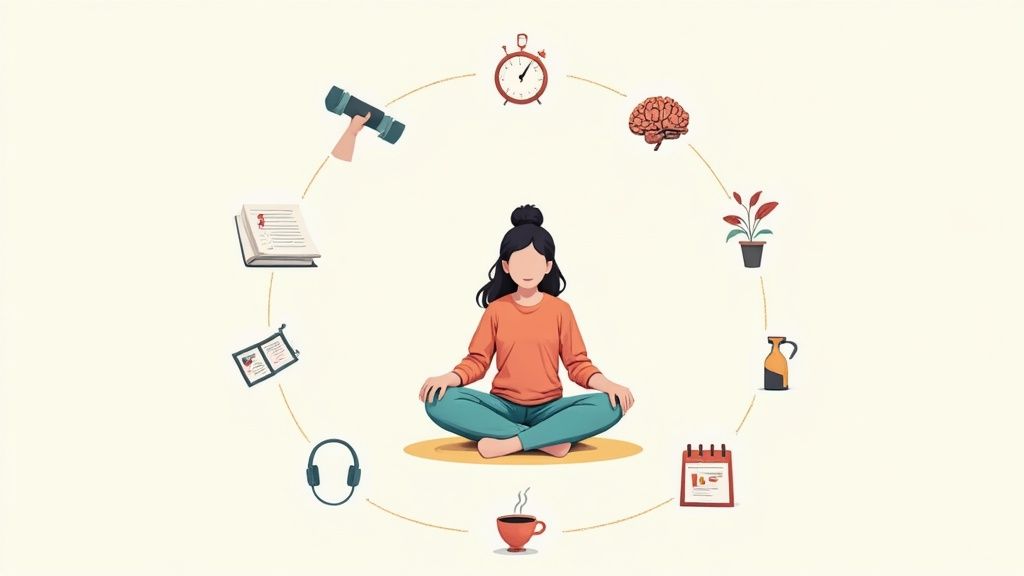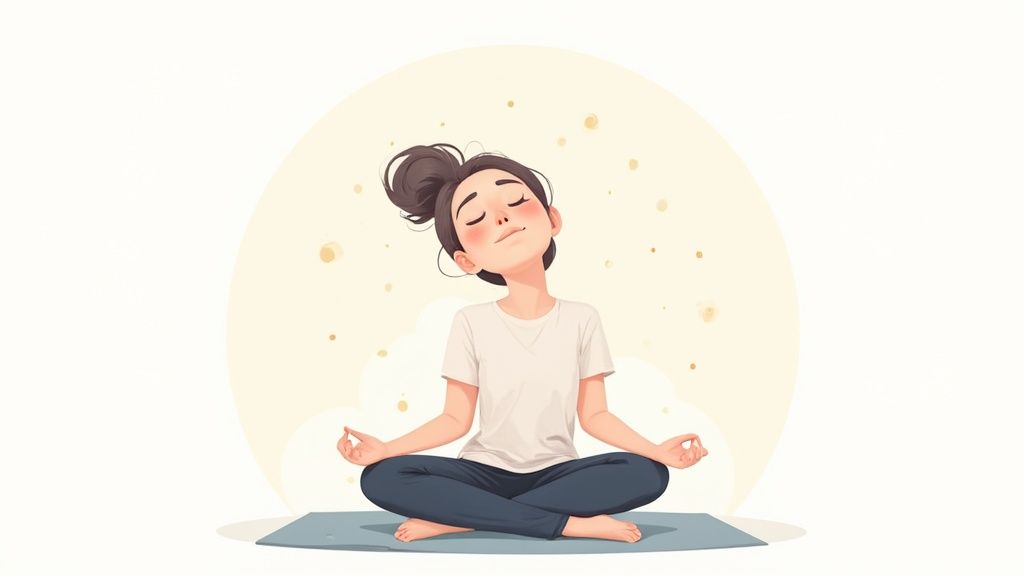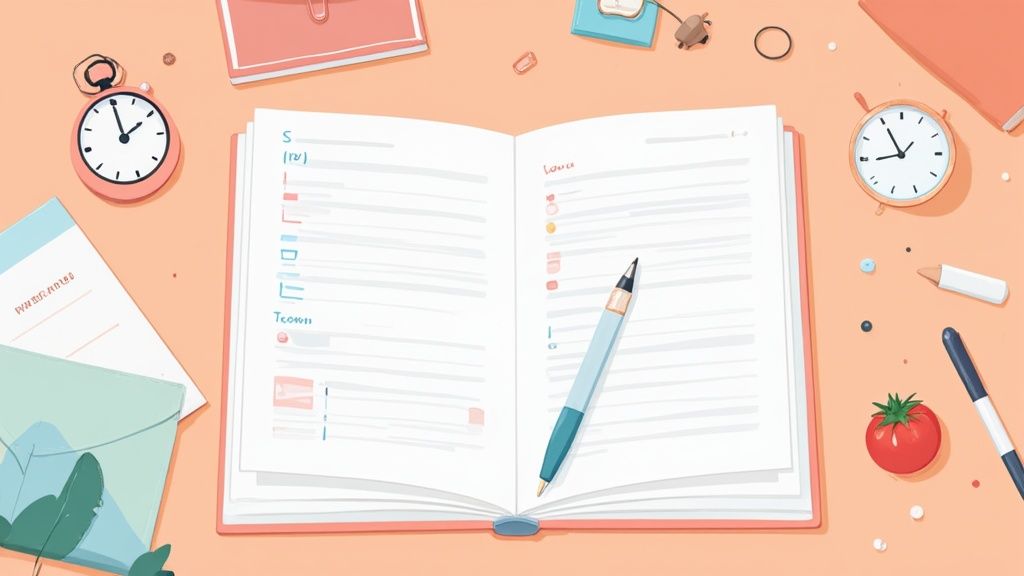Stress management techniques for students: 10 proven tips

Student life is a balancing act of deadlines, exams, social pressures, and future planning. This constant juggle can lead to significant stress, impacting not only academic performance but also mental and physical well-being. The goal isn't to eliminate stress entirely, an impossible task, but to build a robust system for managing it effectively. This guide provides a toolkit of proven stress management techniques for students, moving beyond generic advice to offer practical, actionable strategies for building resilience.
We will explore 10 specific methods, from mindfulness meditation to cognitive behavioral techniques, each designed to fit into a demanding academic schedule. For each technique, we'll provide clear steps for implementation and demonstrate how you can use a centralized system like Obsibrain to track, schedule, and integrate these practices into your daily routine. By the end, you'll have a clear framework for transforming feelings of overwhelm into a sense of control and clarity. This approach will help you stay on top of your academic goals without sacrificing your health, ensuring you can navigate the pressures of student life with confidence.
1. Mindfulness Meditation
Mindfulness meditation is a powerful mental practice that involves focusing your attention on the present moment without judgment. As a student, your mind is often racing with deadlines, exam pressures, and social obligations. This technique helps you observe those thoughts and feelings as they arise, acknowledge them, and then gently let them pass, rather than getting caught in a spiral of anxiety. By practicing controlled breathing and mental awareness, you can calm your nervous system, reduce stress, and significantly improve your concentration.

This practice is widely adopted in academic settings. For example, UCLA offers free mindfulness programs for its students, and many at MIT use apps like Insight Timer to integrate daily meditation into their packed schedules.
How to Implement This Technique
To make mindfulness a consistent part of your routine, start small. For a more structured and comprehensive approach to integrating mindfulness into your life, consider programs like Mindfulness Based Stress Reduction (MBSR).
Start with 5 Minutes: You don’t need long sessions. Begin with just five minutes each day, perhaps right before a study block to clear your mind.
Use Guided Meditations: Apps like Headspace and Calm provide guided sessions that make it easy to start, especially if you find it hard to focus on your own.
Be Consistent: Practice at the same time each day to build a strong habit. Consistency is more important than duration.
Don't Judge Yourself: Your mind will wander. The goal isn't to have an empty mind, but to notice when it wanders and gently guide your focus back.
Using Obsibrain for Mindfulness
Integrate this stress management technique directly into your workflow:
Schedule Sessions: Use Obsibrain’s daily planner to block out a 10-minute meditation session each morning before you start your academic tasks.
Track Your Habit: Create a habit tracker in Obsibrain to visually monitor your consistency. You can link this to a reflection note, journaling about how your meditation practice is impacting your focus during study sessions.
Store Guided Meditations: Keep links to your favorite guided meditation videos or audio files in a dedicated "Mindfulness" note for easy access.
2. Physical Exercise
Regular physical activity is one of the most effective stress management techniques for students. When you exercise, your body releases endorphins, which act as natural mood elevators, and it helps reduce levels of cortisol, the body's primary stress hormone. For a student juggling classes, assignments, and exams, incorporating exercise provides a powerful outlet for pent-up tension, improving sleep quality, cognitive function, and overall academic performance.

This approach is heavily promoted by university wellness programs. Many schools include gym memberships in student fees, offer diverse intramural sports, and run campus fitness groups, making it highly accessible. The World Health Organization (WHO) also provides clear guidelines on physical activity, reinforcing its importance for mental well-being.
How to Implement This Technique
Finding a sustainable way to integrate physical activity is key. A balanced routine ensures you can manage stress without adding another source of pressure to your schedule.
Find an Activity You Enjoy: Whether it's a campus yoga class, a running club, or intramural basketball, you're more likely to stick with something you find fun.
Start Small: You don’t need to commit to an hour-long gym session every day. Begin with 20-30 minutes of moderate activity and build from there.
Use Campus Facilities: Take advantage of the university gym, pool, or running tracks. They are convenient and cost-effective resources.
Exercise with Friends: Partnering with a friend provides social benefits and creates accountability, making it easier to stay consistent.
Using Obsibrain for Physical Exercise
Turn your fitness goals into a consistent, stress-reducing habit:
Schedule Workouts: Use Obsibrain’s planner to block out time for your workouts, treating them with the same importance as a class lecture or study session.
Track Your Progress: Create a dedicated tracker for your physical activity. Visualizing your consistency builds momentum and motivation. Learn more about how to set up your habit tracker in Obsibrain.
Create Workout Plans: Store your workout routines, links to fitness videos, or running routes in a dedicated "Fitness" note, making it easy to grab and go.
3. Deep Breathing Exercises
Deep breathing exercises are one of the simplest yet most effective stress management techniques for students, activating the body's natural relaxation response. These controlled breathing patterns, such as diaphragmatic or "belly" breathing, stimulate the parasympathetic nervous system, which helps lower your heart rate, reduce blood pressure, and counteract the physiological symptoms of stress. When faced with an overwhelming assignment or pre-exam jitters, a few intentional breaths can provide immediate calm and mental clarity.
This technique is widely promoted in high-pressure environments. For instance, the 4-7-8 breathing method, popularized by Dr. Andrew Weil, is taught in university counseling centers, while box breathing is a staple for military personnel and athletes to maintain composure under pressure.
How to Implement This Technique
To harness the power of your breath, focus on integrating specific, proven methods into your day. For a deep dive into different methods, resources like Breathwrk offer guided exercises for various goals.
Try the 4-7-8 Technique: Before an exam or presentation, inhale through your nose for 4 seconds, hold your breath for 7 seconds, and exhale slowly through your mouth for 8 seconds.
Use Box Breathing for Anxiety Spikes: When you feel overwhelmed, inhale for 4 counts, hold for 4, exhale for 4, and hold for 4. Repeat this cycle until you feel centered.
Be Consistent: Practice for a few minutes daily, even when you aren't stressed. This builds the skill so it becomes a natural, automatic response when you need it most.
Combine with Visualization: As you breathe, visualize tension leaving your body with each exhale to enhance the relaxing effect.
Using Obsibrain for Deep Breathing
Integrate this stress management technique directly into your workflow:
Create Breathing Reminders: Use Obsibrain to set reminders before study blocks or exams with a note to perform a 3-minute box breathing exercise.
Log Your Triggers: In your Obsibrain daily journal, track moments of high stress. Link this to a checklist of your favorite breathing exercises, so you have an immediate action plan when anxiety strikes.
Build a Quick-Access Toolkit: Create a note titled "Stress Toolkit" and pin it for easy access. Inside, include instructions for your top 3 breathing techniques for instant relief.
4. Time Management and Organization
One of the biggest sources of academic stress comes from feeling overwhelmed by a seemingly endless to-do list. Effective time management and organization directly combat this by giving you control over your workload. This technique involves strategically planning your tasks, creating realistic schedules, and breaking down large projects into smaller, manageable steps. By eliminating the chaos of last-minute cramming and poor planning, you can significantly reduce anxiety and improve your academic performance.

This proactive approach is championed by productivity experts like David Allen, whose "Getting Things Done" methodology helps millions feel more in control. Similarly, students at universities like Stanford leverage tools such as Asana and Google Calendar to coordinate complex group projects and personal schedules, turning potential chaos into structured success.
How to Implement This Technique
To master your schedule and reduce stress, you need a system that works for you. Start by integrating simple yet powerful habits into your weekly routine. For a deeper dive into organizing your workload effectively, you can explore advanced task management features.
Break It Down: Divide large assignments like a research paper into smaller milestones: topic selection, outline, first draft, and final review. This makes the project feel less daunting.
Use the Pomodoro Technique: Work in focused 25-minute intervals, followed by a 5-minute break. This method, developed by Francesco Cirillo, maintains high concentration and prevents burnout.
Prioritize Ruthlessly: Use a system like the Eisenhower Matrix to decide what is urgent and important, helping you focus your energy on high-impact tasks.
Plan Your Week: Set aside time every Sunday to review upcoming deadlines and block out study time in your calendar. A clear plan for the week provides peace of mind.
Using Obsibrain for Time Management
Leverage Obsibrain’s built-in tools to transform your planning process:
Create Project Dashboards: Use Obsibrain to create a central dashboard for each course, linking lecture notes, readings, and assignment deadlines in one place. This provides a clear overview and reduces the mental load of tracking everything separately.
Automate Your To-Do List: Set up recurring tasks for weekly readings or study sessions. This ensures you never fall behind and reduces the mental load of remembering every little thing.
Implement Pomodoro Timers: Within a task note, create a simple checklist for your Pomodoro sessions (e.g., "Pomodoro 1: Research," "Pomodoro 2: Outline") to track focused work intervals for a specific assignment.
5. Journaling and Expressive Writing
Journaling is the practice of writing down your thoughts and feelings to understand them more clearly. For students navigating academic pressures and personal challenges, this technique serves as a private space to externalize stress, process complex emotions, and gain perspective. Expressive writing, a concept pioneered by researcher Dr. James Pennebaker, involves exploring deep-seated feelings about difficult events, which has been shown to improve both mental health and immune function. It helps you untangle the knots of anxiety and clarify your thinking.

This method is incredibly versatile. Many students use a bullet journal to organize reflections, while others find that a simple gratitude journal before bed significantly reduces stress. For those looking to begin this powerful practice, explore insights on how to start journaling for self-discovery and mental clarity to build a sustainable habit.
How to Implement This Technique
To effectively use journaling as one of your core stress management techniques for students, focus on consistency and honesty rather than perfect prose.
Start with Timed Sessions: Set a timer for 10-15 minutes and write continuously without stopping to edit or judge your thoughts. This is often called a "brain dump."
Use Prompts: If you're unsure where to begin, use prompts like, "What is currently causing me the most stress?" or "What went well today?"
Keep It Private: Knowing your journal is for your eyes only allows for complete honesty, which is crucial for processing difficult emotions.
Review Past Entries: Occasionally look back at your writing to identify recurring stress triggers and emotional patterns, helping you develop better coping strategies.
Using Obsibrain for Journaling
Integrate this stress management technique directly into your workflow:
Create a Daily Journal: Use Obsibrain’s daily notes feature as your digital journal. The platform’s quick capture and notes capability makes it easy to jot down thoughts as they arise throughout the day.
Tag Your Entries: Tag entries with keywords like
#anxiety,#examstress, or#gratitude. This allows you to easily search and review patterns in your emotional state over time, connecting your feelings directly to academic events.Use Journaling Templates: Create a simple template with prompts like "Today's Stressor," "My Reaction," and "A Better Approach" to guide your reflections and turn journaling into a problem-solving tool.
6. Social Support and Peer Connection
Building and maintaining meaningful relationships with friends and peers is a fundamental stress management technique for students. The pressures of academia can often lead to isolation, but social connection provides emotional support, offers fresh perspectives on problems, and fosters a crucial sense of belonging. Sharing challenges with others who understand your situation validates your feelings and makes overwhelming tasks feel more manageable.
This approach is actively promoted by universities worldwide. For instance, Cornell University’s "Let's Meditate" program includes group sessions to foster community, while many institutions have peer counseling services where students support one another through shared experiences, reducing stigma and building strong bonds.
How to Implement This Technique
Intentionally nurturing your social connections is key, even when your schedule is packed. For a deeper understanding of how social ties impact well-being, explore resources from organizations like the Jed Foundation, which focuses on student mental health.
Schedule Social Time: Treat social activities like any other important appointment. Block out time in your calendar for coffee with a friend or a group study session.
Join a Club or Group: Aligning with your interests, whether academic or recreational, is an easy way to meet like-minded people.
Be Open with Trusted Peers: Sharing your struggles with a close friend can lighten your emotional load and often leads to reciprocal support.
Attend Campus Events: Make an effort to go to community gatherings, workshops, or residence hall activities to build a sense of community.
Using Obsibrain for Social Connection
Leverage Obsibrain to mindfully manage your social life:
Track Social Engagements: Use Obsibrain’s calendar to schedule and track social events, study groups, and club meetings, ensuring you balance academic work with vital social time.
Create a "People" Note: Keep a dedicated note for important people in your support network. Jot down reminders to check in with friends, especially during stressful periods like midterms, fostering stronger, more consistent relationships.
Log Group Project Details: For study groups, create a shared note space to track meeting times, agendas, and shared resources, making collaboration less stressful.
7. Progressive Muscle Relaxation (PMR)
Progressive Muscle Relaxation (PMR) is a physical technique where you systematically tense specific muscle groups and then release them. For students who carry stress physically, like in tense shoulders or clenched jaws, this practice is a game-changer. It teaches you to recognize the feeling of physical tension and consciously let it go, activating your body's natural relaxation response and easing anxiety. By focusing on this physical release, you can effectively reduce physiological stress, calm your mind, and prepare for restful sleep.
This method, developed by Dr. Edmund Jacobson, is a cornerstone of many stress management programs. University wellness centers often hold workshops teaching PMR, and therapists frequently recommend it for managing anxiety. You'll also find countless guided PMR videos on YouTube specifically designed to help students unwind before bed or after a long study session.
How to Implement This Technique
To make PMR an effective part of your stress management toolkit, focus on the physical sensations. The key is the contrast between tension and complete relaxation.
Start from the Toes: Begin by tensing the muscles in your feet for five seconds, then release for ten seconds, noticing the difference. Work your way up your body.
Use Guided Recordings: Initially, follow guided audio or video to learn the sequence without having to think about it.
Practice Before Bed: PMR is incredibly effective for improving sleep quality. A 15-minute session before bed can help release the day's physical stress.
Be Consistent: Aim for 3-4 sessions per week to train your body to release tension more readily.
Using Obsibrain for PMR
Integrate this powerful physical technique into your student life:
Create a PMR Checklist: In your daily notes or a dedicated "Wellness" template, create a simple checklist of the muscle groups (feet, calves, thighs, etc.) to guide you through the sequence without needing a screen.
Link Guided Resources: Embed links to your favorite guided PMR videos from YouTube directly into your "Stress Management" note in Obsibrain for quick and easy access during study breaks or before sleep.
Schedule PMR Sessions: Add a recurring task in your Obsibrain planner for a 15-minute PMR session before bed to build it into your evening wind-down routine.
8. Nature and Outdoor Activity
Stepping away from screens and into natural environments is a potent form of stress relief. Known as "nature therapy" or "green time," this technique involves intentionally spending time outdoors to calm the mind and body. For students immersed in digital learning and high-pressure academic settings, this practice offers a crucial counterbalance. Exposure to nature is scientifically proven to lower cortisol levels, reduce blood pressure, and improve overall mood, providing a much-needed perspective on academic stressors.
The concept is widely supported by environmental psychology research and popularized by figures like Dr. Qing Li through his work on "forest bathing." Many universities embrace this by creating campus gardens, nature walks, and outdoor meditation areas. Stanford University, for example, actively promotes its green spaces as resources for student well-being.
How to Implement This Technique
Integrating nature into your student life doesn't require elaborate trips. The key is to make small, consistent efforts to connect with the natural world around you, even in an urban campus setting.
Schedule Green Time: Treat a 20-minute walk in a local park as you would any other important appointment.
Disconnect to Reconnect: Leave your phone on silent or in your bag to fully immerse yourself in the environment and give your mind a true break.
Combine with Other Activities: Suggest an outdoor study session with a friend, or do some light reading on a campus green.
Bring Nature Indoors: If getting outside is difficult, caring for a small desk plant can provide a similar, albeit smaller, mental health boost.
Using Obsibrain for Outdoor Activity
Leverage Obsibrain to ensure nature becomes a non-negotiable part of your stress management toolkit:
Map Local Green Spaces: Create a note in Obsibrain listing nearby parks, trails, and quiet campus spots. You can even embed a map or link photos to remind you of your options. Link this note to your weekly planner for easy access.
Set Recurring Reminders: Use Obsibrain’s task management to create a recurring daily task like "Take a 15-minute walk outside" to build the habit.
Log Nature Journal Entries: After a walk, use Obsibrain's quick capture to jot down a few sentences about how you feel. This reinforces the positive connection between nature and your mental state.
9. Cognitive Behavioral Techniques
Cognitive Behavioral Techniques (CBT) are powerful mental strategies that help you identify, challenge, and reframe negative or irrational thought patterns. As a student, it's easy to fall into cycles of catastrophic thinking ("If I fail this exam, my whole future is ruined") or perfectionism. CBT addresses the root cause of this stress by changing the way you think, rather than just treating the symptoms. It empowers you to break free from unhelpful mental habits that fuel anxiety.
These techniques are a cornerstone of modern therapy and are widely used in campus counseling centers. Many students also use apps like MindShift CBT and Sanvello, which digitize these practices, making them accessible anytime you feel overwhelmed.
How to Implement This Technique
Integrating CBT into your life involves actively questioning your thoughts. For a deeper understanding of common cognitive distortions, you can explore resources like the Beck Institute, founded by the creator of Cognitive Therapy.
Keep a Thought Record: When you feel stressed, write down the situation, your automatic negative thought, and the emotions it triggered.
Challenge Your Thoughts: Ask yourself: What is the evidence for this thought? What is the evidence against it? Is there a more balanced way to see this?
Practice Reframing: Consciously rephrase negative thoughts into more constructive ones. For example, change "I'm terrible at this subject" to "I find this topic challenging, so I'll seek extra help."
Start Small: Don't try to challenge every negative thought at once. Focus on one recurring thought pattern each week.
Using Obsibrain for CBT
Integrate this stress management technique directly into your workflow:
Create a Thought Record Template: Design a template in Obsibrain to quickly log and analyze your thoughts whenever stress arises. Fields could include "Situation," "Automatic Thought," "Evidence For/Against," and "Reframed Thought."
Build a Coping Statement Library: Create a note with a list of positive, realistic coping statements that you can reference during high-pressure moments like exam season. You can link specific statements to course notes (e.g., link "I am prepared for this calculus exam" to your calculus study dashboard).
Track Patterns: By tagging your thought records (e.g.,
#perfectionism,#impostersyndrome), you can use Obsibrain's graph view to visualize connections and identify recurring negative thought patterns related to specific subjects or situations.
10. Campus Counseling and Professional Support
Sometimes, self-managed techniques aren't enough, and seeking professional help is a powerful step toward managing overwhelming stress. Campus counseling services offer access to trained mental health professionals who provide confidential, evidence-based support tailored to student life. These services are designed to help you navigate academic pressure, anxiety, depression, and other challenges in a safe and structured environment.
This resource is a cornerstone of student wellness on nearly every campus. Organizations like the JED Foundation actively partner with universities to strengthen these programs, making professional mental health care more accessible than ever. Most universities offer a set number of counseling sessions for free or at a very low cost, removing financial barriers to getting help.
How to Implement This Technique
Taking the first step can be daunting, but universities provide multiple entry points to make it easier. For an in-depth look at how campuses are supporting student mental health, you can explore resources from organizations like the Association for University and College Counseling Center Directors (AUCCCD).
Visit Early: Counseling centers often have waitlists, so reach out at the beginning of the semester before stress peaks.
Explore Group Sessions: If one-on-one therapy feels intimidating, consider joining a workshop on stress management or study skills as a lower-barrier entry point.
Utilize Telehealth: Many universities now offer virtual counseling appointments, providing a convenient and private way to connect with a professional.
Be Open and Honest: To get the most out of your sessions, be honest with your counselor about your symptoms and struggles. They are there to help without judgment.
Using Obsibrain for Professional Support
Keep your mental health journey organized and integrated with your academic life:
Appointment Management: Use Obsibrain’s calendar to schedule and set reminders for your counseling appointments, including location details or virtual meeting links.
Session Notes: Create a secure, private note in your vault to jot down thoughts, key takeaways, or things you want to discuss during your next session. This helps you track progress and make sessions more productive.
Store Important Information: Keep a confidential note with your counselor's contact information, campus mental health hotline numbers, and links to online wellness resources provided by your university, ensuring help is always one click away.
10 Student Stress-Management Techniques Compared
Mindfulness Meditation
🔄 Low — easy to start but requires consistent practice
⚡ Minimal — no equipment; apps optional; 5–20 min/session
⭐📊 Reduces anxiety, improves focus and emotion regulation (best with regular practice)
💡 Before studying, daily routine, general stress reduction
Accessible, evidence-based, integrates into daily life
Physical Exercise
🔄 Moderate — planning and technique can be needed
⚡ Variable — time (20–60 min), possible equipment or facilities
⭐📊 High — improves mood, sleep, energy, and cognitive clarity
💡 To relieve built-up stress, boost energy, and improve sleep
Immediate mood boost; physical and mental health benefits
Deep Breathing Exercises
🔄 Very low — simple techniques to learn
⚡ Minimal — can be done anywhere in 1–5 minutes
⭐📊 Immediate short-term stress reduction; temporary relief
💡 During exams, presentations, panic spikes or acute anxiety
Fast, discreet, no equipment
Time Management & Organization
🔄 Moderate — initial setup and ongoing maintenance
⚡ Low — tools/apps and time investment to plan
⭐📊 High — reduces procrastination and deadline stress; improves performance
💡 Project planning, exam prep, managing heavy workloads
Prevents last-minute crises; increases productivity and control
Journaling & Expressive Writing
🔄 Low — easy to begin but benefits require consistency
⚡ Minimal — notebook or app; 5–30 min/session
⭐📊 Moderate — improves emotional clarity and problem-solving
💡 Processing emotions, reflection after stressful events, pattern detection
Private, therapeutic, enhances self-awareness
Social Support & Peer Connection
🔄 Moderate — requires effort to build and maintain
⚡ Low to moderate — time and access to groups or peers
⭐📊 High — reduces isolation, improves resilience and mental health
💡 Ongoing academic/personal challenges; crisis buffering
Mutual support, perspective, sense of belonging
Progressive Muscle Relaxation (PMR)
🔄 Low–Moderate — learn sequence; practice needed
⚡ Minimal — quiet space; 10–20 min/session
⭐📊 Good — reduces physical tension and improves sleep quality
💡 Before bed, to relieve tension-related headaches or neck pain
Targets somatic stress; complements breathing/meditation
Nature & Outdoor Activity
🔄 Low — straightforward but requires access/time
⚡ Low — access to green spaces and time blocks (10+ min)
⭐📊 Moderate–High — lowers cortisol, improves mood and focus
💡 Restorative breaks, combined with walking or outdoor study
Combines exercise and mindfulness; often free and restorative
Cognitive Behavioral Techniques (CBT)
🔄 High — requires learning and regular practice
⚡ Moderate — time, structured exercises; therapist guidance helpful
⭐📊 High — addresses root causes; produces durable cognitive change
💡 Persistent anxiety, maladaptive thinking, long-term coping skill building
Evidence-based, long-term resilience and emotional regulation
Campus Counseling & Professional Support
🔄 Moderate — scheduling and intake processes
⚡ Moderate — professional staff, appointments; possible wait times
⭐📊 High — tailored, evidence-based treatment and crisis support
💡 Severe or persistent mental health issues; crisis intervention
Professional, confidential, comprehensive and personalized care
Building Your Personal Stress Management System
Navigating the demands of academic life can feel like a constant balancing act. The pressure of deadlines, exams, and social expectations can easily accumulate, making effective stress management not just a helpful skill, but an essential component of student well-being and success. Throughout this guide, we've explored ten powerful stress management techniques for students, from the quiet introspection of mindfulness meditation to the proactive organization of time management and the vital support found in peer connections.
The goal isn't to master every single technique overnight. Instead, the most sustainable path to resilience is to build a personalized, integrated system that fits your unique personality, schedule, and challenges. Think of these techniques as individual tools in a toolkit; the true power comes from knowing which tool to use and when, and how to combine them for maximum effect.
From Theory to Daily Practice
The critical transition from knowing these techniques to using them consistently is where many students falter. This is where creating a structured, intentional system becomes a game-changer. The key is to transform stress management from an occasional emergency response into a proactive, daily habit woven directly into your student workflow.
Here’s a practical path forward:
Select Your Starting Trio: Don't try to implement all ten techniques at once. Choose two or three that resonate most with you. Perhaps it's combining Time Management for academic control, Physical Exercise for physical release, and Journaling for emotional processing.
Schedule and Track: The best intentions fail without a plan. Use your Obsibrain Daily Note to schedule a 10-minute deep breathing session before your morning study block or a 30-minute walk after your last class. Create a simple tracker with checkboxes to build momentum and see your consistency grow over time.
Integrate, Don't Isolate: Connect your stress management practices to your academic tasks. For example, use a 5-minute Progressive Muscle Relaxation exercise as a "reset" between studying different subjects. Link your journal entries about exam anxiety directly to your study notes for that course, creating a holistic view of your academic and mental state.
Review and Adapt: Your needs will change throughout the semester. What works during a calm week might not be enough during final exams. Use a weekly review template in Obsibrain to assess what's working. Are you feeling overwhelmed? Maybe it’s time to lean more heavily on Cognitive Behavioral Techniques or schedule a visit to campus counseling, adding that appointment directly to your Obsibrain calendar.
By treating stress management with the same seriousness as your academic planning, you build a resilient foundation. This proactive approach ensures you're not just surviving your student years but actively thriving. Mastering these skills now will pay dividends long after graduation, equipping you with the emotional and mental fortitude to navigate any challenge life throws your way. You are not just earning a degree; you are building a more balanced, resilient, and successful self.
Ready to build your integrated academic and wellness system? Obsibrain provides the templates, workflows, and structure you need to turn these stress management techniques for students into consistent, life-changing habits. Start organizing your notes, tasks, and well-being in one powerful space by visiting Obsibrain today.
Last updated
Was this helpful?